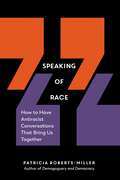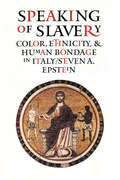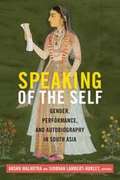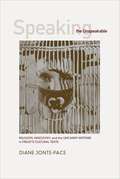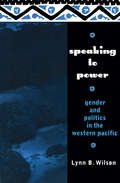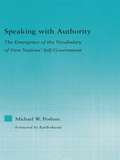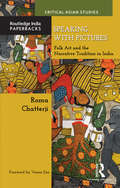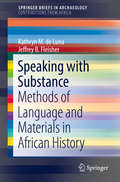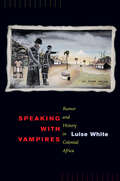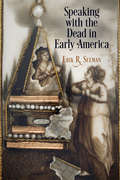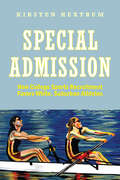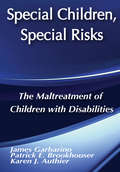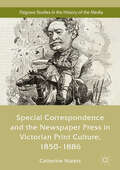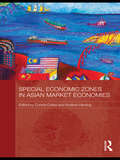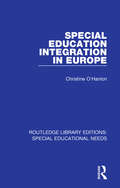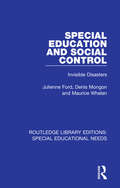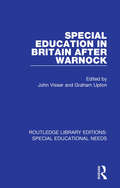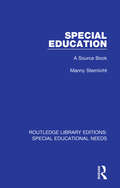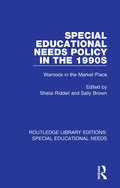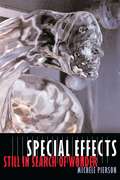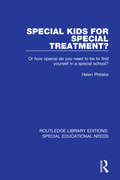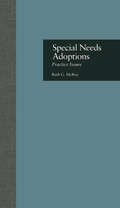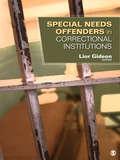- Table View
- List View
Speaking of Race: How To Have Antiracist Conversations That Bring Us Together
by Patricia Roberts-Miller“Readers of all levels and backgrounds will appreciate the clarity with which Roberts-Miller approaches a topic so often driven by powerful emotion.”—Choice It’s easy to say that racism is wrong. But it’s surprisingly hard to agree on what it is. Does a tired stereotype in your favorite movie make it racist? Does watching it anyway mean you’re racist? Even among like-minded friends, such discussions can quickly escalate to hurt feelings all around—and when they do, we lose valuable opportunities to fight racism. Patricia Roberts-Miller is a scholar of rhetoric—the art of understanding misunderstandings. In Speaking of Race, she explains why the subject is a “third rail” and how we can do better: We can acknowledge that, in a racist society, racism is not the sole provenance of “bad people.” We can focus on the harm it causes rather than the intent of offenders. And, when someone illuminates our own racist blind spots, we can take it not as a criticism, but as a kindness—and an opportunity to learn and to become less racist ourselves.
Speaking of Slavery: Color, Ethnicity, and Human Bondage in Italy (Conjunctions of Religion and Power in the Medieval Past)
by Steven A. EpsteinIn this highly original work, Steven A. Epstein shows that the ways Italians employ words and think about race and labor are profoundly affected by the language used in medieval Italy to sustain a system of slavery. The author's findings about the surprising persistence of the "language of slavery" demonstrate the difficulty of escaping the legacy of a shameful past.For Epstein, language is crucial to understanding slavery, for it preserves the hidden conditions of that institution. He begins his book by discussing the words used to conduct and describe slavery in Italy, from pertinent definitions given in early dictionaries, to the naming of slaves by their masters, to the ways in which bondage has been depicted by Italian writers from Dante to Primo Levi and Antonio Gramsci. Epstein then probes Italian legal history, tracing the evolution of contracts for buying, selling, renting, and freeing people. Next he considers the behaviors of slaves and slave owners as a means of exploring how concepts of liberty and morality changed over time. He concludes by analyzing the language of the market, where medieval Italians used words to fix the prices of people they bought and sold.The first history of slavery in Italy ever published, Epstein's work has important implications for other societies, particularly America's. "For too long," Epstein notes, "Americans have studied their own slavery as it if were the only one ever to have existed, as if it were the archetype of all others." His book allows citizens of the United States and other former slave-holding nations a richer understanding of their past and present.
Speaking of Spain: The Evolution of Race and Nation in the Hispanic World
by Antonio FerosMomentous changes swept Spain in the fifteenth century: royal marriage united its two largest kingdoms, the last Muslim emirate fell to Catholic armies, and conquests in the Americas were turning Spain into a great empire. Yet few people could define “Spanishness” concretely. Antonio Feros traces Spain’s evolving ideas of nationhood and ethnicity.
Speaking of the Self: Gender, Performance, and Autobiography in South Asia
by Anshu Malhotra Siobhan Lambert-HurleyMany consider the autobiography to be a Western genre that represents the self as fully autonomous. The contributors to Speaking of the Self challenge this presumption by examining a wide range of women's autobiographical writing from South Asia. Expanding the definition of what kinds of writing can be considered autobiographical, the contributors analyze everything from poetry, songs, mystical experiences, and diaries to prose, fiction, architecture, and religious treatises. The authors they study are just as diverse: a Mughal princess, an eighteenth-century courtesan from Hyderabad, a nineteenth-century Muslim prostitute in Punjab, a housewife in colonial Bengal, a Muslim Gandhian devotee of Krishna, several female Indian and Pakistani novelists, and two male actors who worked as female impersonators. The contributors find that in these autobiographies the authors construct their gendered selves in relational terms. Throughout, they show how autobiographical writing--in whatever form it takes--provides the means toward more fully understanding the historical, social, and cultural milieu in which the author performs herself and creates her subjectivity.Contributors: Asiya Alam, Afshan Bokhari, Uma Chakravarti, Kathryn Hansen, Siobhan Lambert-Hurley, Anshu Malhotra, Ritu Menon, Shubhra Ray, Shweta Sachdeva Jha, Sylvia Vatuk
Speaking the Unspeakable: Religion, Misogyny, and the Uncanny Mother in Freud's Cultural Texts
by Diane Jonte-PaceIn this bold rereading of Freud's cultural texts, Diane Jonte-Pace uncovers an undeveloped "counter thesis," one that repeatedly interrupts or subverts his well-known Oedipal masterplot. The counter thesis is evident in three clusters of themes within Freud's work: maternity, mortality, and immortality; Judaism and anti-Semitism; and mourning and melancholia.
Speaking to Power: Gender and Politics in the Western Pacific
by Lynn WilsonFor nearly fifty years, US government officials have identified Belau, in western Micronesia, as a key strategic site and have implemented administrative policies designed to maintain permanent access to Belau's land, reefs and waters for military purposes. Elder women placed themselves at the forefront of opposition to these policies, and, as part of oppositional efforts, successfully entered international political arenas. Speaking to Power moves beyond examining the impact of militarism and colonial administrative policy in Belau and draws on feminist poststructural analysis to explore the fluidity of contests in constructions of "gender," "politics," and "tradition" during US administration in Belau.
Speaking with Authority: The Emergence of the Vocabulary of First Nations' Self-Government (Indigenous Peoples and Politics)
by Michael W. PoslunsThis work explores the emergence of the vocabulary of First Nations' self-government into the realm of public and parliamentary discourse in Canada during the decade of the 1970s. The emergence of the vocabulary is chronicled through a study of the testimony of First Nations and aboriginal witnesses before a series of Joint Committees on the Constitutions and the Commons Committee on Indian Affairs and Northern Development.
Speaking with Pictures: Folk Art and the Narrative Tradition in India (Critical Asian Studies)
by Roma ChatterjiSpeaking with Pictures offers a path-breaking exploration of visual narratives in folk art. It foregrounds folk art’s engagement with modernity by re-looking at its figurative modes and the ways in which they are embedded in mythic thought. The book discusses folk art as a contemporary phenomenon which is a part of a complex visual culture where the ‘essence’ of tradition is best captured in a ‘new’ form or medium. Each chapter picks up a theme that moves between the local and the global, thereby attempting to problematise the stereotypical view of folk artists as carriers of ‘timeless tradition’. The volume provides an ethnographic account of innovations through a detailed analysis of the scroll painting tradition of the patuas of West Bengal and the Pardhan-Gond style of Madhya Pradesh, highlighting some recent attempts at inter-medium exchange in storytelling.The book will interest those in visual and popular culture in anthropology, sociology, literary criticism and folklore. It will also be of immense value to art historians, museologists, curators and NGOs working in media and communication, apart from those with a general interest in folk art.
Speaking with Substance: Methods of Language and Materials in African History (SpringerBriefs in Archaeology)
by Kathryn M. de Luna Jeffrey B. FleisherThis volume proposes a supplemental approach to interdisciplinary historical reconstructions that draw on archaeological and linguistic data. The introduction lays out the supplemental approach, situating it in the broader context of similar interdisciplinary research methods in other world regions. Reflecting the arguments of the volume and its goal to document the process rather than the outcome of interdisciplinary collaboration, the volume is organized into two two-chapter case studies. Within each case study, the non-specialist develops an historical interpretation using their own research findings and published data from the other discipline.This chapter is followed by critical commentary from the specialist, a dialogue clarifying the commentary and specialists’ methods, and a second short historical interpretation that deploys insights from the supplemental approach. The conclusion reflects on the challenges of disciplinary conventions to interdisciplinary research and the contribution of the supplemental approach to efforts to know the history of oral societies in Africa and beyond
Speaking with Vampires: Rumor and History in Colonial Africa (Studies on the History of Society and Culture #37)
by Luise WhiteDuring the colonial period, Africans told each other terrifying rumors that Africans who worked for white colonists captured unwary residents and took their blood. In colonial Tanganyika, for example, Africans were said to be captured by these agents of colonialism and hung upside down, their throats cut so their blood drained into huge buckets. In Kampala, the police were said to abduct Africans and keep them in pits, where their blood was sucked. Luise White presents and interprets vampire stories from East and Central Africa as a way of understanding the world as the storytellers did. Using gossip and rumor as historical sources in their own right, she assesses the place of such evidence, oral and written, in historical reconstruction. White conducted more than 130 interviews for this book and did research in Kenya, Uganda, and Zambia. In addition to presenting powerful, vivid stories that Africans told to describe colonial power, the book presents an original epistemological inquiry into the nature of historical truth and memory, and into their relationship to the writing of history.
Speaking with the Dead in Early America (Early American Studies)
by Erik R. SeemanIn late medieval Catholicism, mourners employed an array of practices to maintain connection with the deceased—most crucially, the belief in purgatory, a middle place between heaven and hell where souls could be helped by the actions of the living. In the early sixteenth century, the Reformation abolished purgatory, as its leaders did not want attention to the dead diminishing people's devotion to God. But while the Reformation was supposed to end communication between the living and dead, it turns out the result was in fact more complicated than historians have realized. In the three centuries after the Reformation, Protestants imagined continuing relationships with the dead, and the desire for these relations came to form an important—and since neglected—aspect of Protestant belief and practice.In Speaking with the Dead in Early America, historian Erik R. Seeman undertakes a 300-year history of Protestant communication with the dead. Seeman chronicles the story of Protestants' relationships with the deceased from Elizabethan England to puritan New England and then on through the American Enlightenment into the middle of the nineteenth century with the explosion of interest in Spiritualism. He brings together a wide range of sources to uncover the beliefs and practices of both ordinary people, especially women, and religious leaders. This prodigious research reveals how sermons, elegies, and epitaphs portrayed the dead as speaking or being spoken to, how ghost stories and Gothic fiction depicted a permeable boundary between this world and the next, and how parlor songs and funeral hymns encouraged singers to imagine communication with the dead. Speaking with the Dead in Early America thus boldly reinterprets Protestantism as a religion in which the dead played a central role.
Spearheads for Reform: The Social Settlements and the Progressive Movement, 1890 to 1914
by Allen F. DavisBeginning in the late 1880s, the social settlement movement brought educated young women and men of the privileged classes into some of the poorest communities of America's cities. Living as "neighbors" to the struggling immigrant families, they attempted to bring about a series of social reforms that they believed would build a better world. This book focuses on the period from the rise of the settlement movement until World War I. It examines the role of the settlements in education, housing, the labor movement, politics, and much more.
Special Admission: How College Sports Recruitment Favors White Suburban Athletes (The American Campus)
by Kirsten HextrumSpecial Admission contradicts the national belief that college sports provide upward mobility opportunities. Kirsten Hextrum documents how white middle-class youth become overrepresented on college teams. Her institutional ethnography of one elite athletic and academic institution includes over 100 hours of interviews with college rowers and track & field athletes. She charts the historic and contemporary relationships between colleges, athletics, and white middle-class communities that ensure white suburban youth are advantaged in special athletic admissions. Suburban youth start ahead in college admissions because athletic merit—the competencies desired by university recruiters—requires access to vast familial, communal, and economic resources, all of which are concentrated in their neighborhoods. Their advantages increase as youth, parents, and coaches strategically invest in and engineer novel opportunities to maintain their race and class status. Thus, college sports allow white, middle-class athletes to accelerate their racial and economic advantages through admission to elite universities.
Special Children, Special Risks: The Maltreatment of Children with Disabilities (Modern Applications Of Social Work Ser.)
by James Garbarino Patrick E. Brookhouser Karen J. AuthierHow does one investigate a child maltreatment case when the victim is blind, mute, deaf, mentally retarded, or confined to an institution? Special Children, Special Risks presents analysis, recommendations, and related research from social work, psychology, psychiatry, medicine, and education essential for establishing and maintaining safe environments for handicapped children.This book brings together a diverse group of experts to pool their knowledge and share their concerns about the risks of abuse faced by handicapped children. The contributors' perspectives come from the fields of medicine, social work, developmental psychology, psychiatry, clinical psychology, education, child welfare, law, public policy, and journalism.
Special Correspondence and the Newspaper Press in Victorian Print Culture, 1850–1886 (Palgrave Studies in the History of the Media)
by Catherine WatersThis book analyses the significance of the special correspondent as a new journalistic role in Victorian print culture, within the context of developments in the periodical press, throughout the second half of the nineteenth century. Examining the graphic reportage produced by the first generation of these pioneering journalists, through a series of thematic case studies, it considers individual correspondents and their stories, and the ways in which they contributed to, and were shaped by, the broader media landscape. While commonly associated with the reportage of war, special correspondents were in fact tasked with routinely chronicling all manner of topical events at home and abroad. What distinguished the work of these journalists was their effort to ‘picture’ the news, to transport readers imaginatively to the events described. While criticised by some for its sensationalism, special correspondence brought the world closer, shrinking space and time, and helping to create our modern news culture.
Special Economic Zones in Asian Market Economies (Routledge Studies in the Growth Economies of Asia)
by Connie CarterSpecial Economic Zones (SEZs) have proliferated rapidly during the past decade and are set to multiply in the next – embracing not only Asia and Europe but also Africa and the Americas. This book is the first to examine the Asian experience of SEZs in China, India, Malaysia and the Philippines. SEZs are usually clearly defined geographic areas in which national, provincial or local governments use policy tools (such as tax holidays; improved infrastructure; less onerous or differentiated regulations and incentives other than those generally available in the rest of the country) to attract and promote private - usually foreign - investment from enterprises which commit to create employment and to export their products or services, and generating foreign currency for the host country. SEZs have been especially successful in bringing about economic development in Asia, especially in China. This book examines the origins, nature and status of special economic zones in Asia, together with the current trends connected with them, and the challenges they currently face. Although the World Trade Organisation cast doubts in 1995 on the future of special economic zones as a viable policy tool in the development agenda, special economic zones continue to be used, and favoured, as a way of encouraging foreign investment and economic development, with for example India, trying to emulate China, reincorporating special economic zones into its development policy. This book provides regional case studies of SEZs in Asian market economies to analyse the extent to which these zones serve the changing needs of Asian development.
Special Education Integration in Europe (Routledge Library Editions: Special Educational Needs #40)
by Christine O'HanlonFirst published in 1993. Any political system must respond to the needs of its’ peoples and the European Community was no exception. This book, an all-round guide to the education of pupils with special educational needs in Europe, examines the policy and practice of special education in what were the twelve EC countries. The process of integrating pupils with special educational needs into mainstream schooling was an educational priority in the practice of many EC countries. The means of achieving this aim are reviewed, as well as an evaluation of the progress in different national educational contexts.
Special Education and Social Control: Invisible Disasters (Routledge Library Editions: Special Educational Needs #19)
by Maurice Whelan Denis Mongon Julienne FordFirst published in 1982. Between 1955 and 1980 the number of pupils in special needs schools in Britain increased tenfold. Between 1970 and 1977 the number of units for ‘difficult’ pupils also increased tenfold and went on increasing. Some observers saw this as a welcome advance in special education, others as an extension of discrimination. The authors of this study highlight the dangers of such a provision being used as a form of social control, which may be imposed on children whose only failure is an inability to fit into the stereotype of the ideal student.
Special Education in Britain after Warnock (Routledge Library Editions: Special Educational Needs #57)
by Graham Upton John VisserFirst published in 1988. With the Education Reform Act 1988 firmly in place and impacting upon the education of children and young people with Special Educational Needs, this book examines the issues that arose from its implementation. It aims to promote debate as well as providing a record of the achievements in practice, policy and provision in Britain since the Warnock Committee reported. The challenges which remain or have been created since the introduction of the Education Act 1981 are also discussed.
Special Education: A Source Book (Routledge Library Editions: Special Educational Needs #51)
by Manny SternlichtFirst published in 1987. This annotated bibliography in the field of special education is designed for teachers of exceptional pupils and other educational personnel so that they may be aware of the research that exists in various areas and so that they may have to hand a source book to which they can refer to when necessary.
Special Educational Needs Policy in the 1990s: Warnock in the Market Place (Routledge Library Editions: Special Educational Needs #43)
by Sheila Riddell Sally BrownThis book, first published in 1994, explores the impact which changes in thinking and policy at national and local level have had upon the educational experiences of children and young people with special needs in England, Scotland and Wales. Two major factors are discussed. Firstly, there is the thinking of the late 1970s which emerges in documents such as the Warnock report and the legislation which followed it. Secondly, the authors examine the educational policy and legislation of the 1980s and early 1990s which aimed to encourage the operation of market forces. Through the various articles in this collection, the contributors discuss both the common themes and the tensions created by these changes, and assess the effect these have had on special needs education in practice.
Special Effects: Still in Search of Wonder (Film and Culture Series)
by Michele PiersonDesigned to trick the eye and stimulate the imagination, special effects have changed the way we look at films and the worlds created in them. Computer-generated imagery (CGI), as seen in Hollywood blockbusters like Star Wars, Terminator 2, Jurassic Park, Independence Day, Men in Black, and The Matrix, is just the latest advance in the evolution of special effects. Even as special effects have been marveled at by millions, this is the first investigation of their broader cultural reception. Moving from an exploration of nineteenth-century popular science and magic to the Hollywood science fiction cinema of our time, Special Effects examines the history, advancements, and connoisseurship of special effects, asking what makes certain types of cinematic effects special, why this matters, and for whom. Michele Pierson shows how popular science magazines, genre filmzines, and computer lifestyle magazines have articulated an aesthetic criticism of this emerging art form and have helped shape how these hugely popular on-screen technological wonders have been viewed by moviegoers.
Special Kids for Special Treatment?: Or how special do you need to be to find yourself in a special school? (Routledge Library Editions: Special Educational Needs #42)
by Helen PhtiakaFirst published in 1997. This book compares and contrasts the experiences of deviant pupils in a mainstream school with that of those in a special unit for pupils with behavioural problems. The author’s aims are to (i) evaluate the differences between the behaviour of deviant boys and girls within the mainstream education system with those without; and (ii) justify the criteria for transferring deviant pupils to special units. Her research shows that there is no uniformity in the deviant behaviour of pupils in either situation. In fact, there are more similarities in the behaviour of pupils across the dividing line than pupils in the same institution. Such findings raise questions about the apparent arbitrary nature if some transferral decisions and, in the longer term, the whole logic of separate schooling for pupils who are considered by some to be a problem. At a time when market forces and competition have distracted the schools’ attention away from the needs of the individual pupil, this book stresses the need for changes at all levels which will make school relevant to the lives of all pupils.
Special Needs Adoptions: Practice Issues
by Ruth G. McRoyFirst published in 1999. Routledge is an imprint of Taylor & Francis, an informa company.
Special Needs Offenders in Correctional Institutions
by Lior GideonEffective treatment and preparation for successful reintegration can be better achieved if the needs and risks of incarcerated offenders are taken into consideration by correctional practitioners and scholars. Special Needs Offenders in Correctional Institutions offers a unique opportunity to examine the different populations behind bars (e.g. chronically and mentally ill, homosexual, illegal immigrants, veterans, radicalized inmates, etc.), as well as their needs and the corresponding impediments for rehabilitation and reintegration. Author Lior Gideon takes a rehabilitative and reiterative approach to discuss and differentiate between the needs of these various categories of inmates, and provides in depth discussions-not available in other correctional texts-about the specific needs, risks and policy recommendations when working with present-day special needs offenders. Each chapter is followed by suggested readings and relevant websites that will enable readers to further enhance understanding of the issues and potential solutions discussed in the chapter. Further, each chapter has discussion questions specifically designed to promote class discussions. The text concludes with a theoretical framework for future policy implications and practices.
